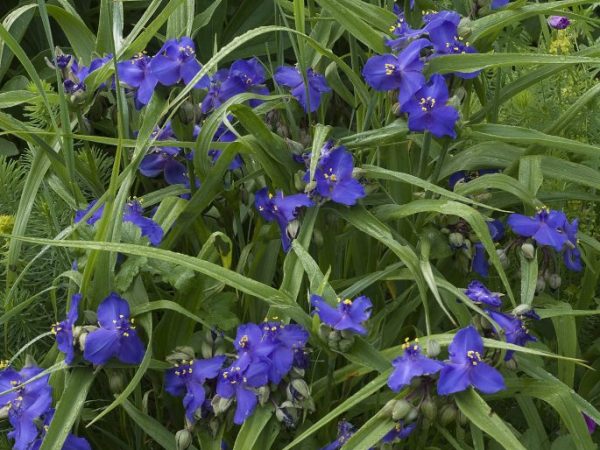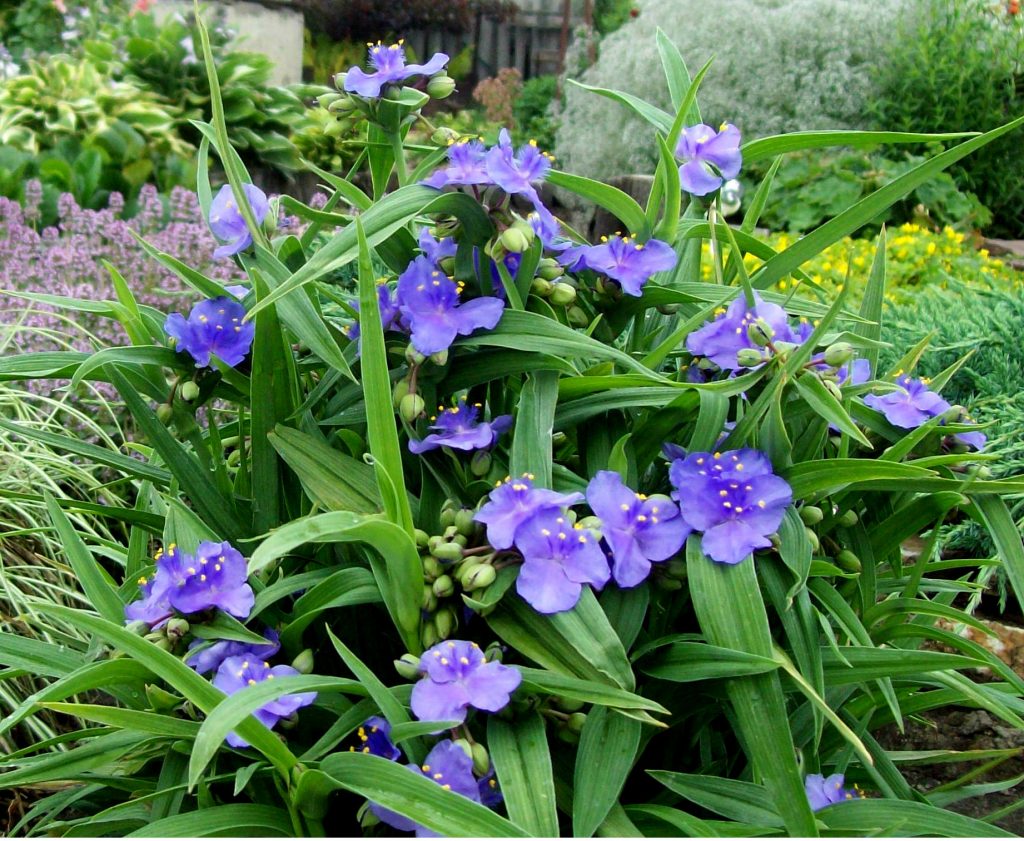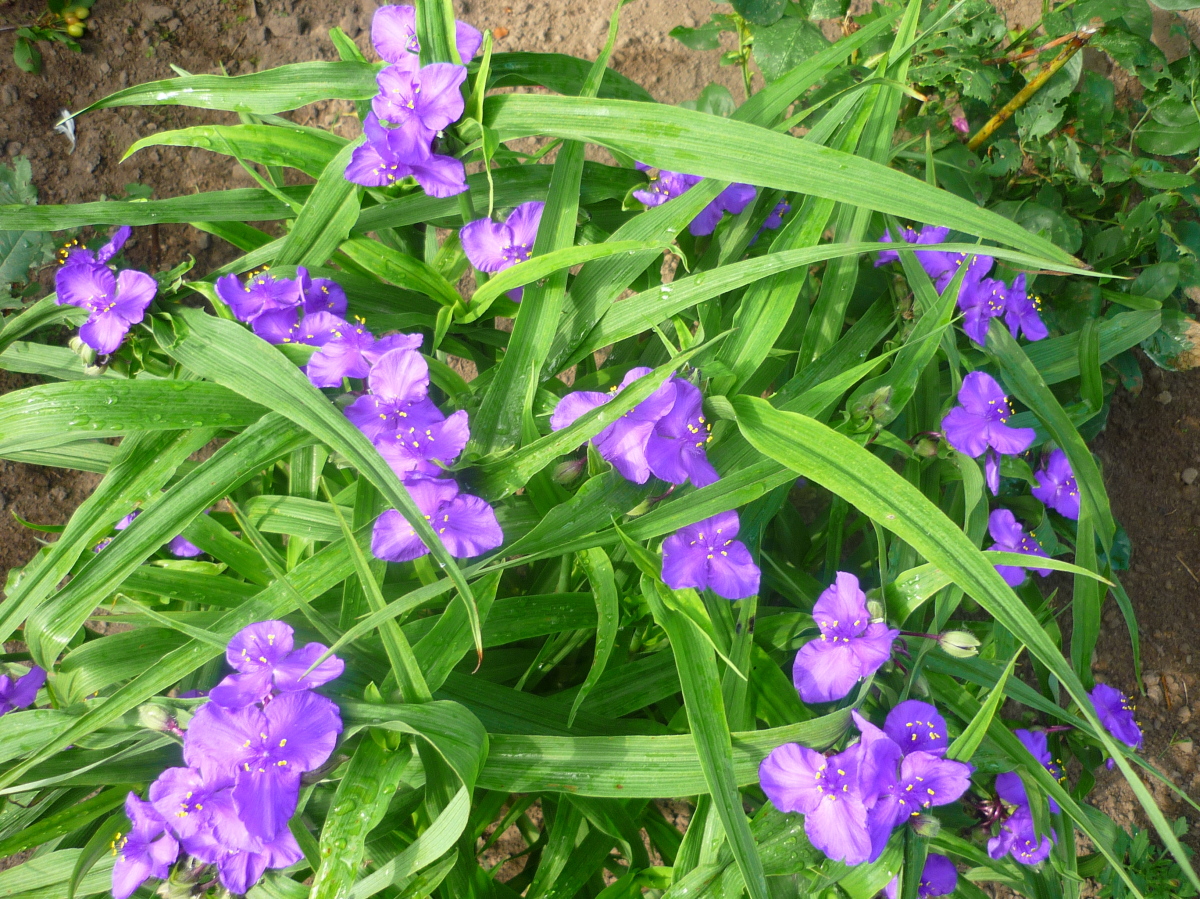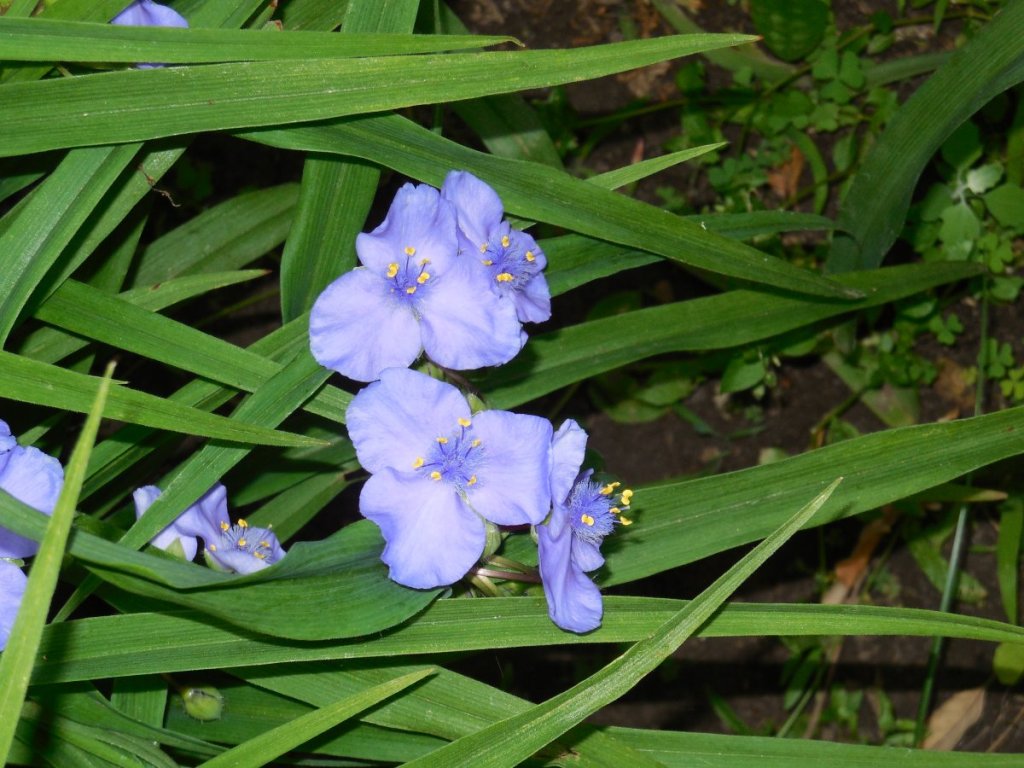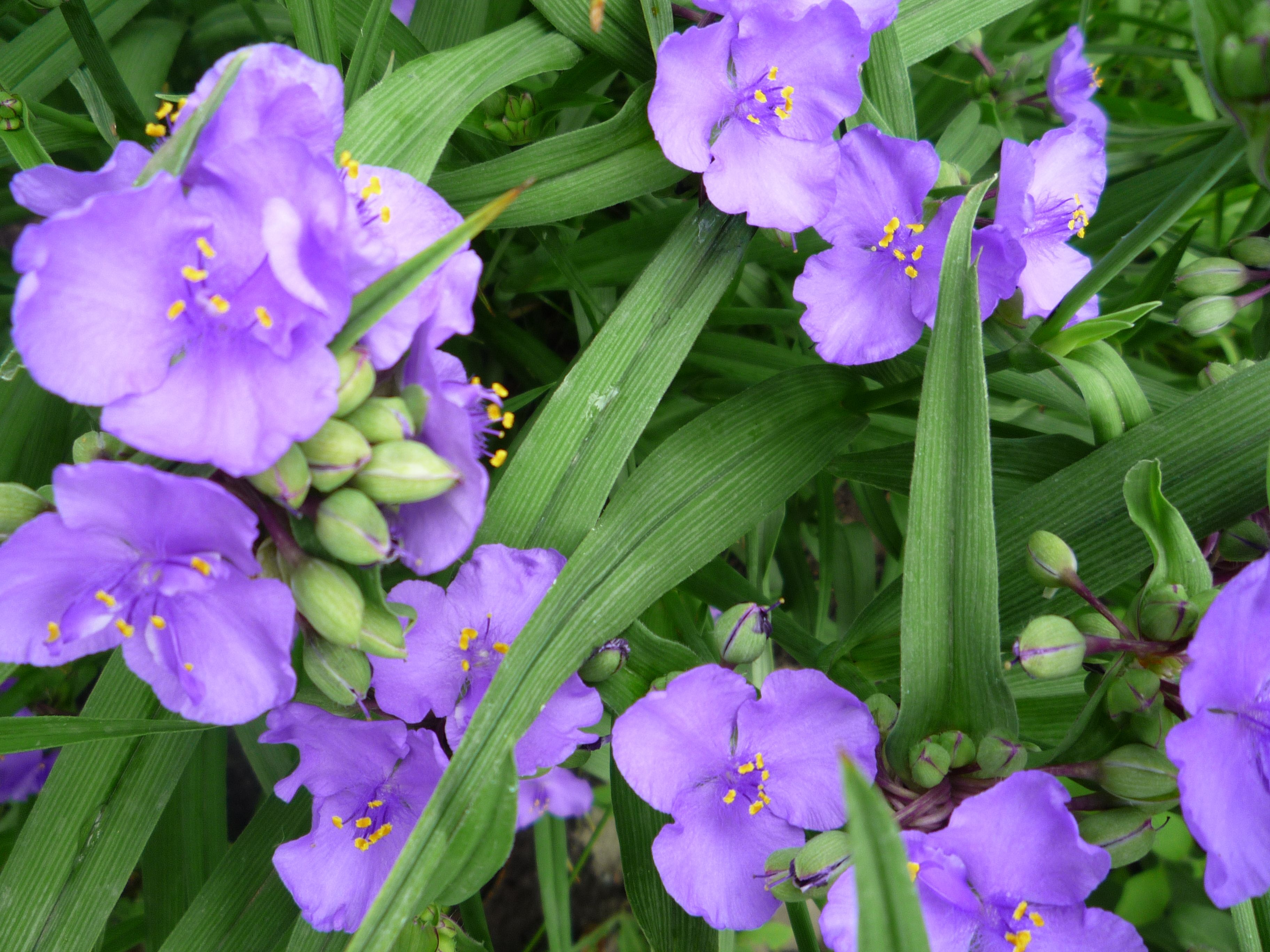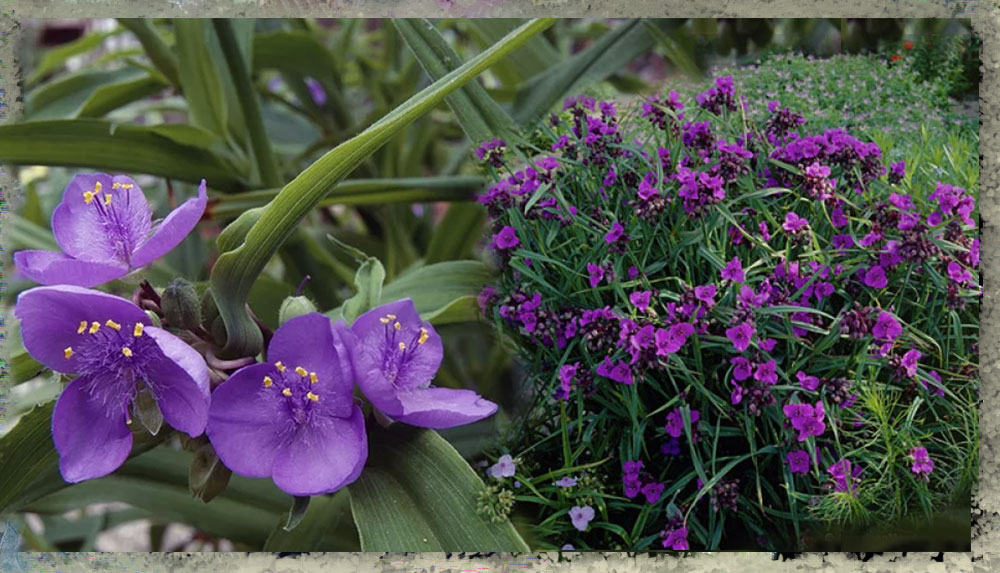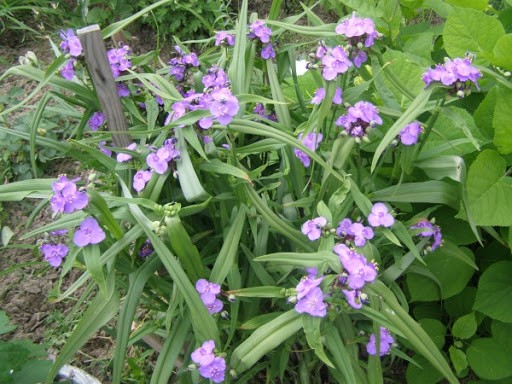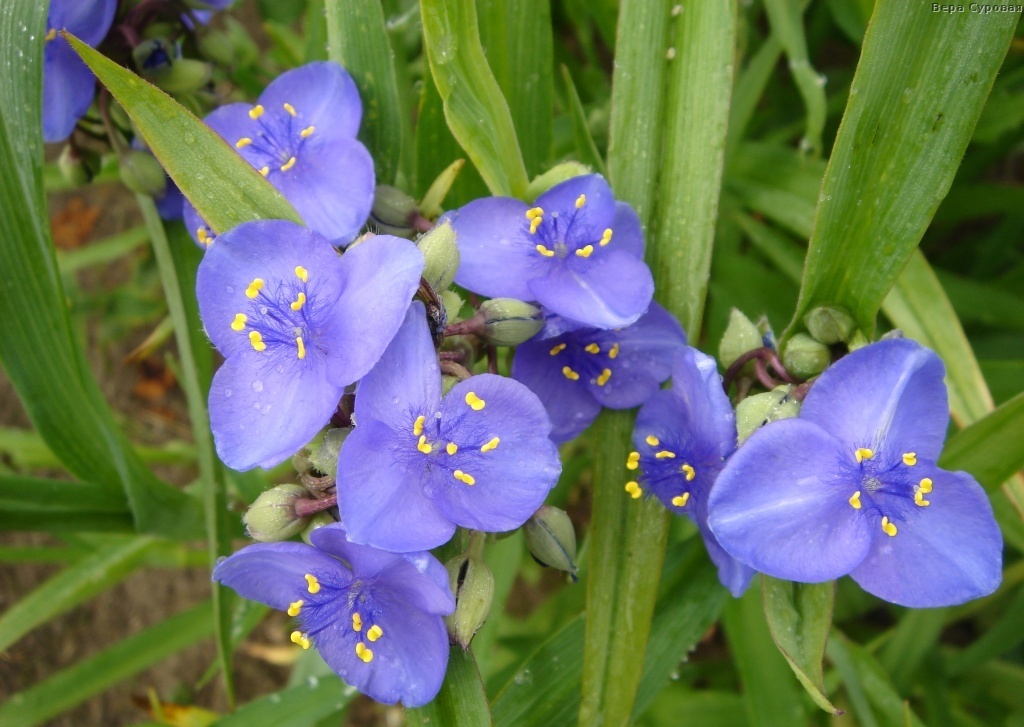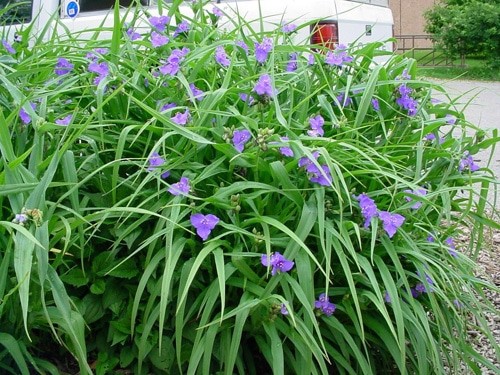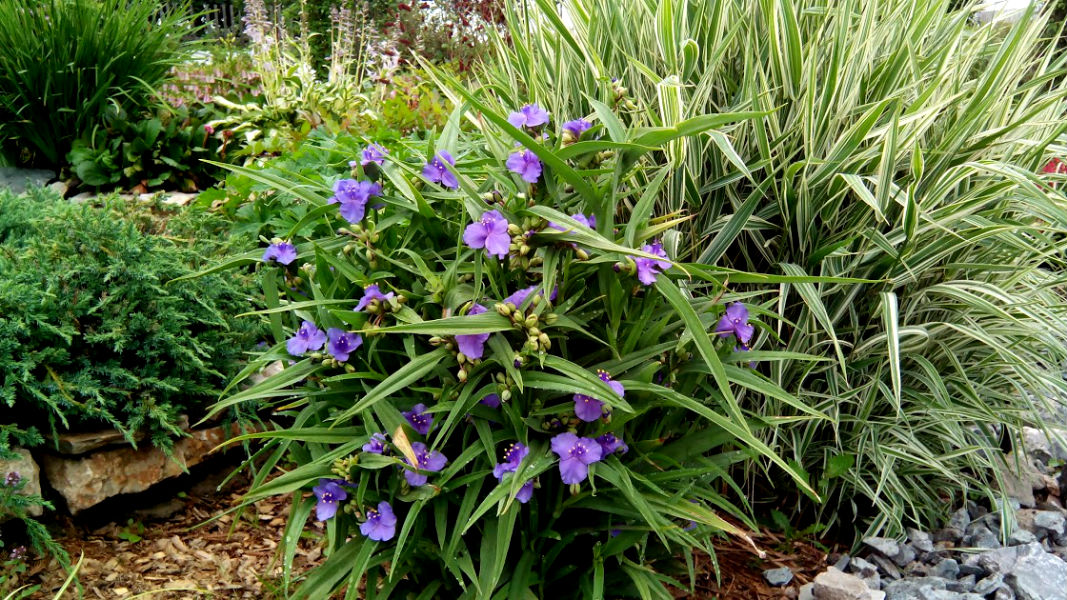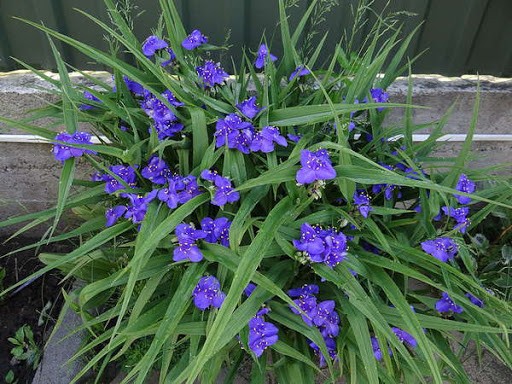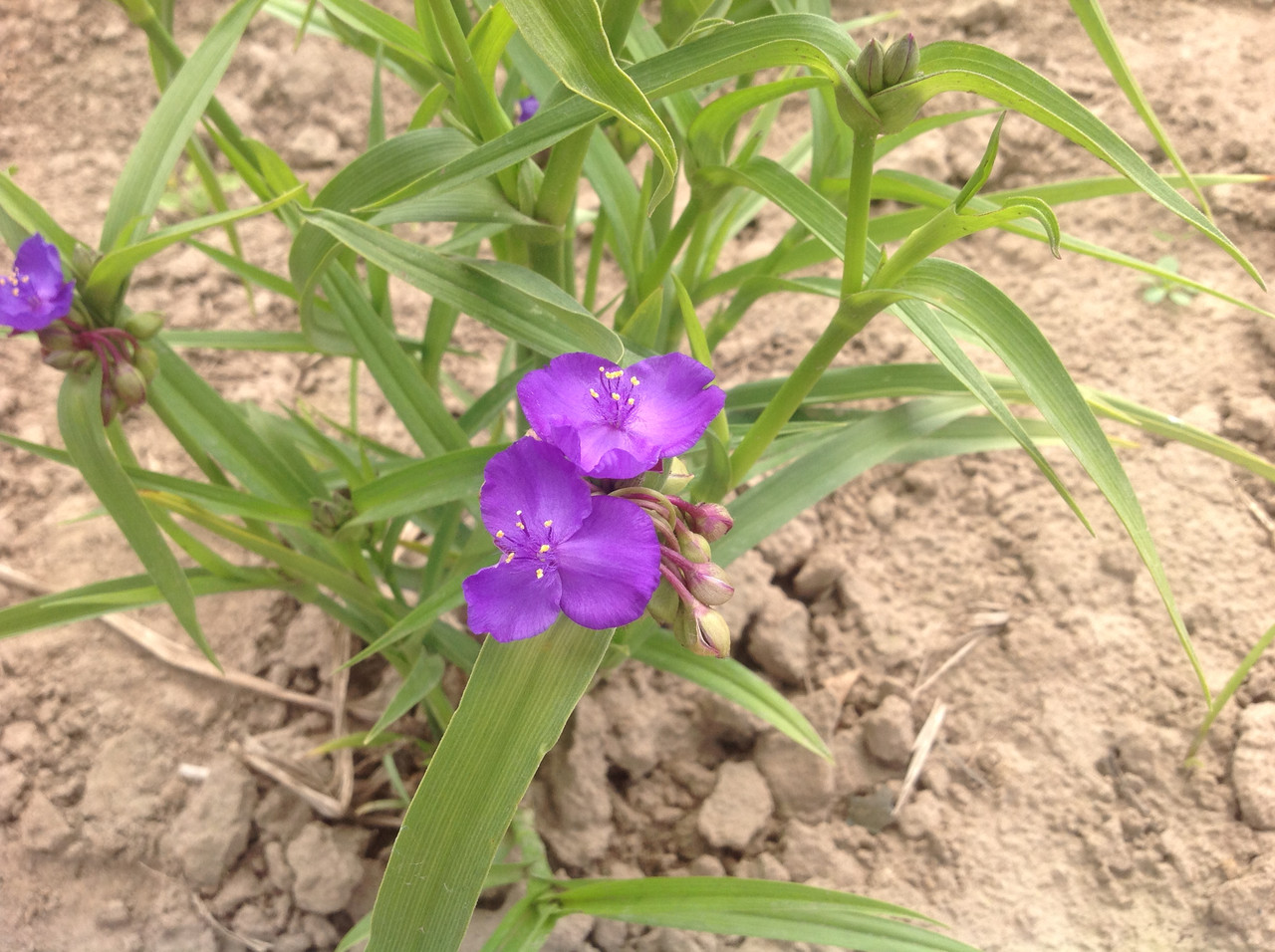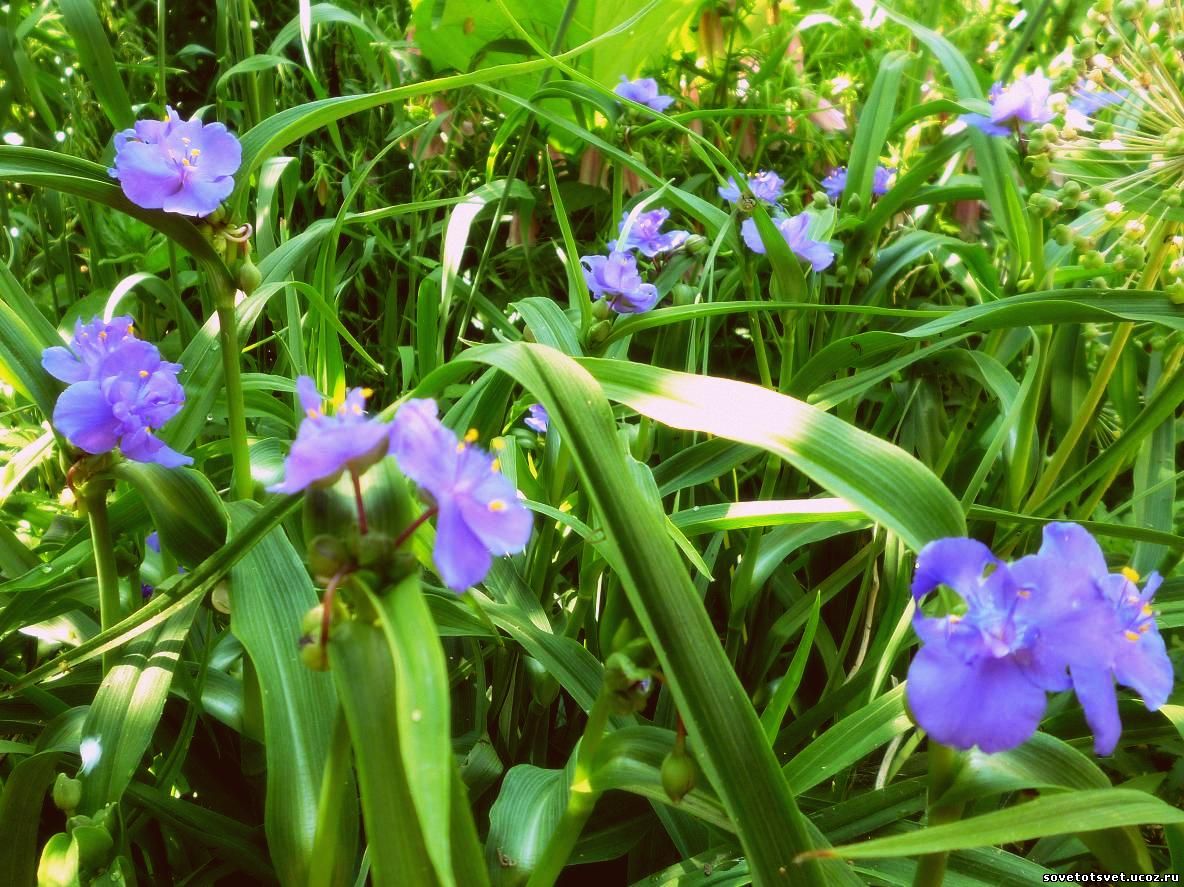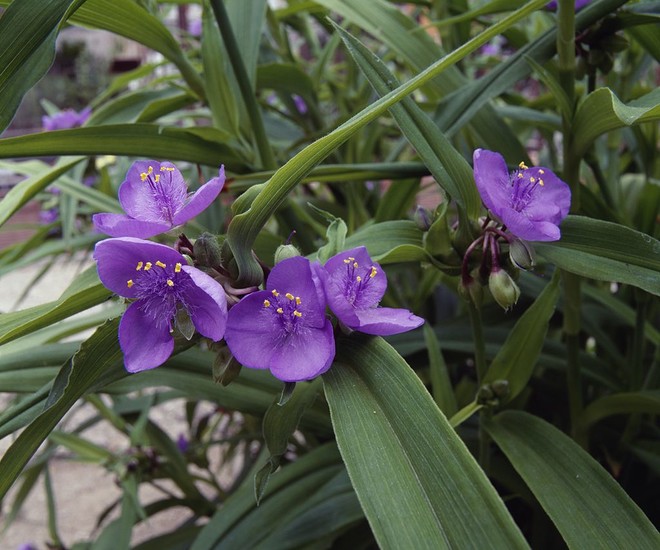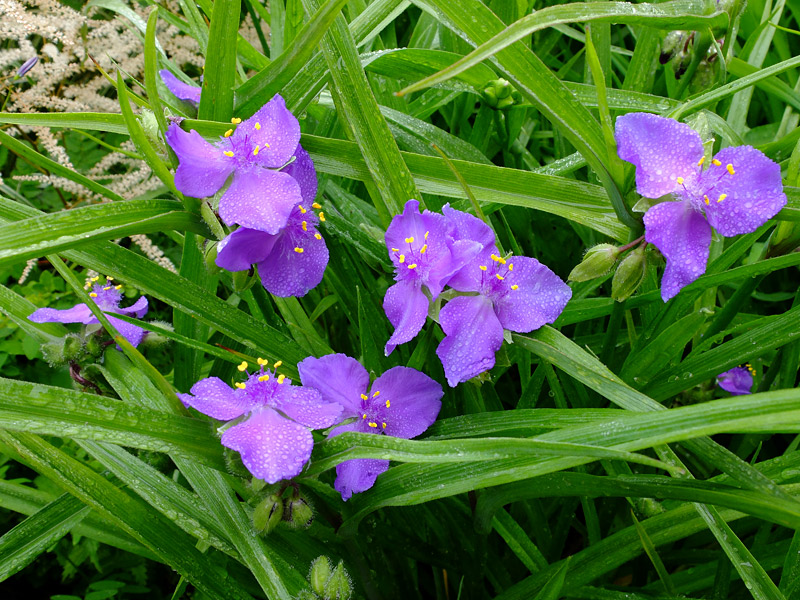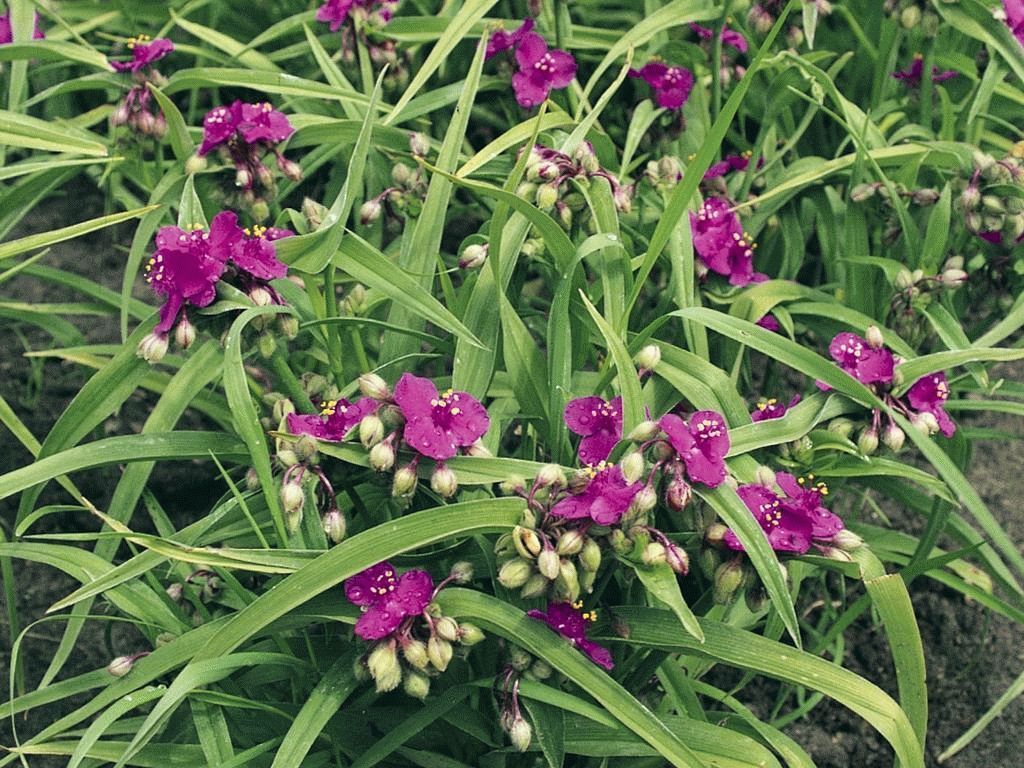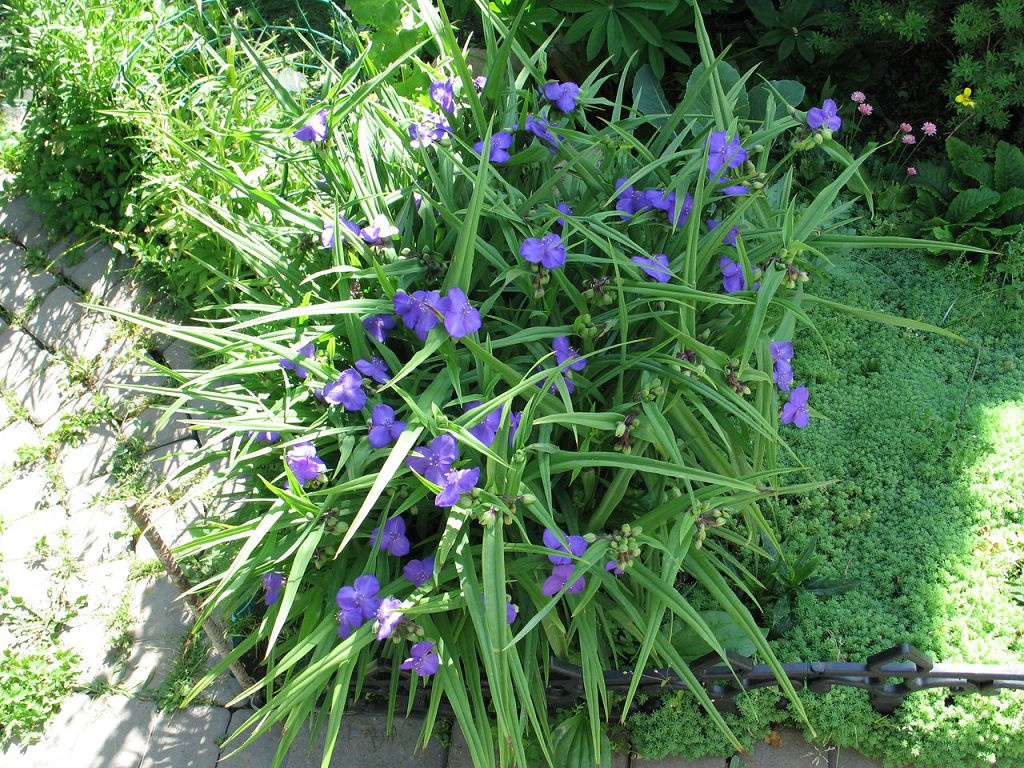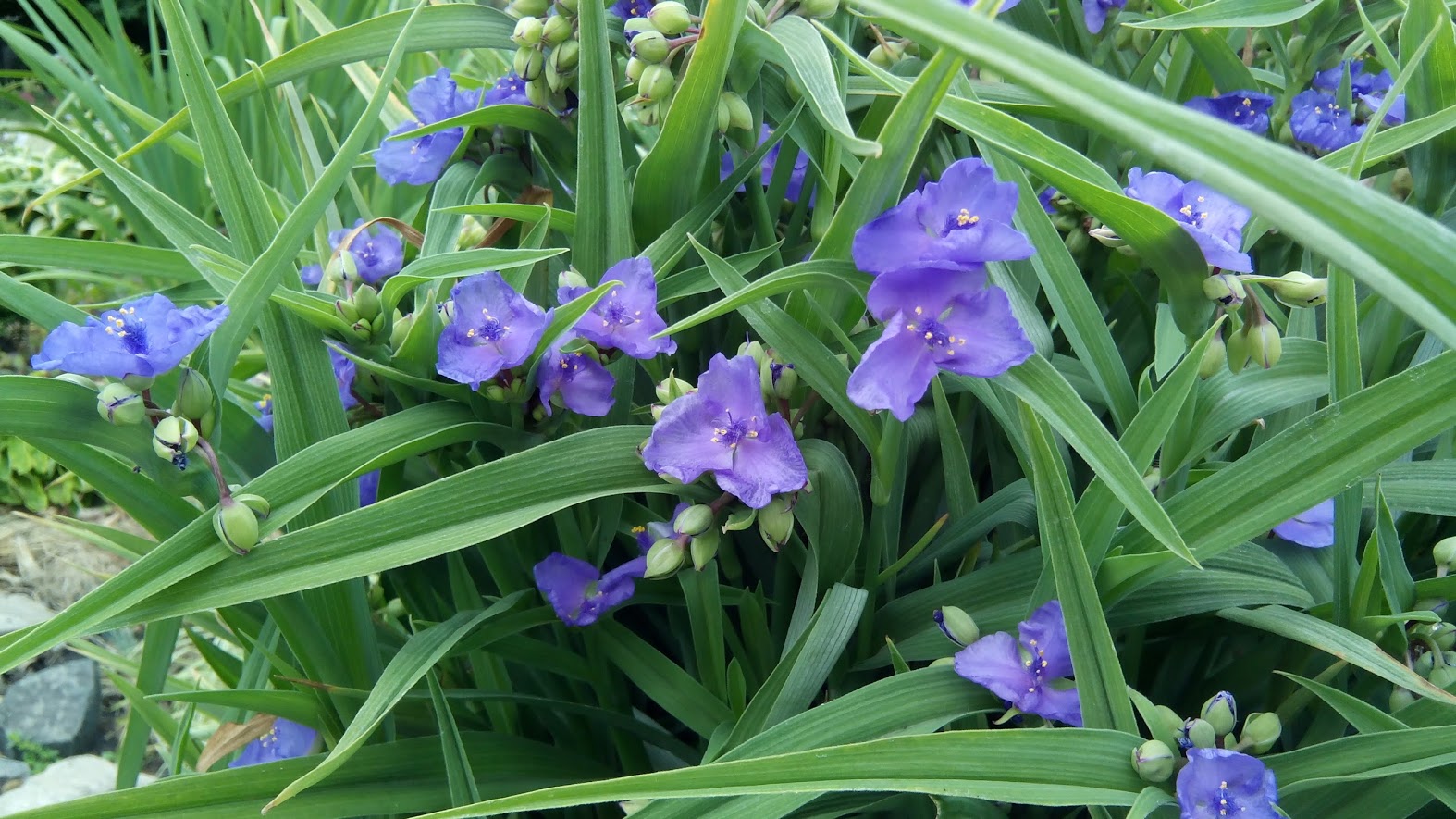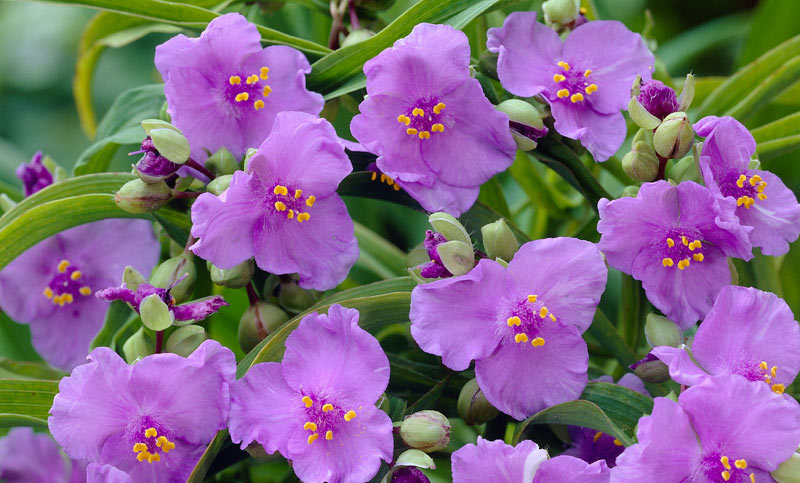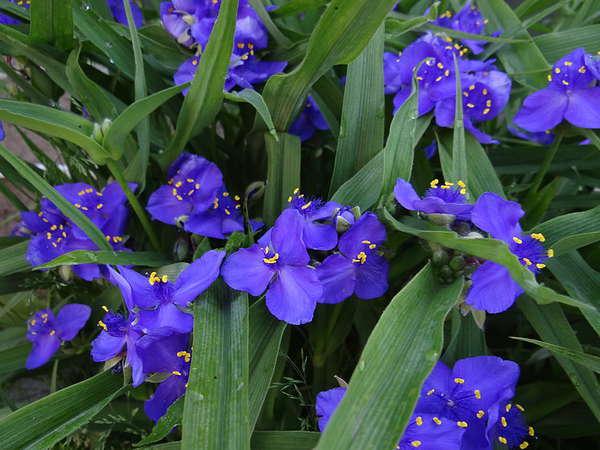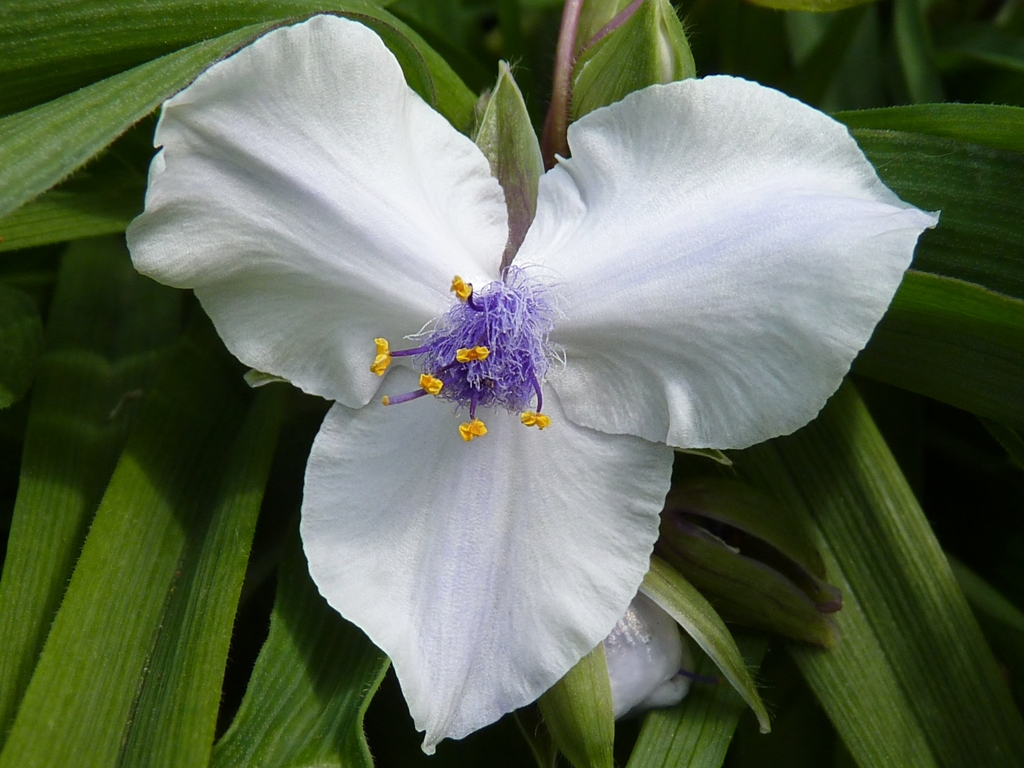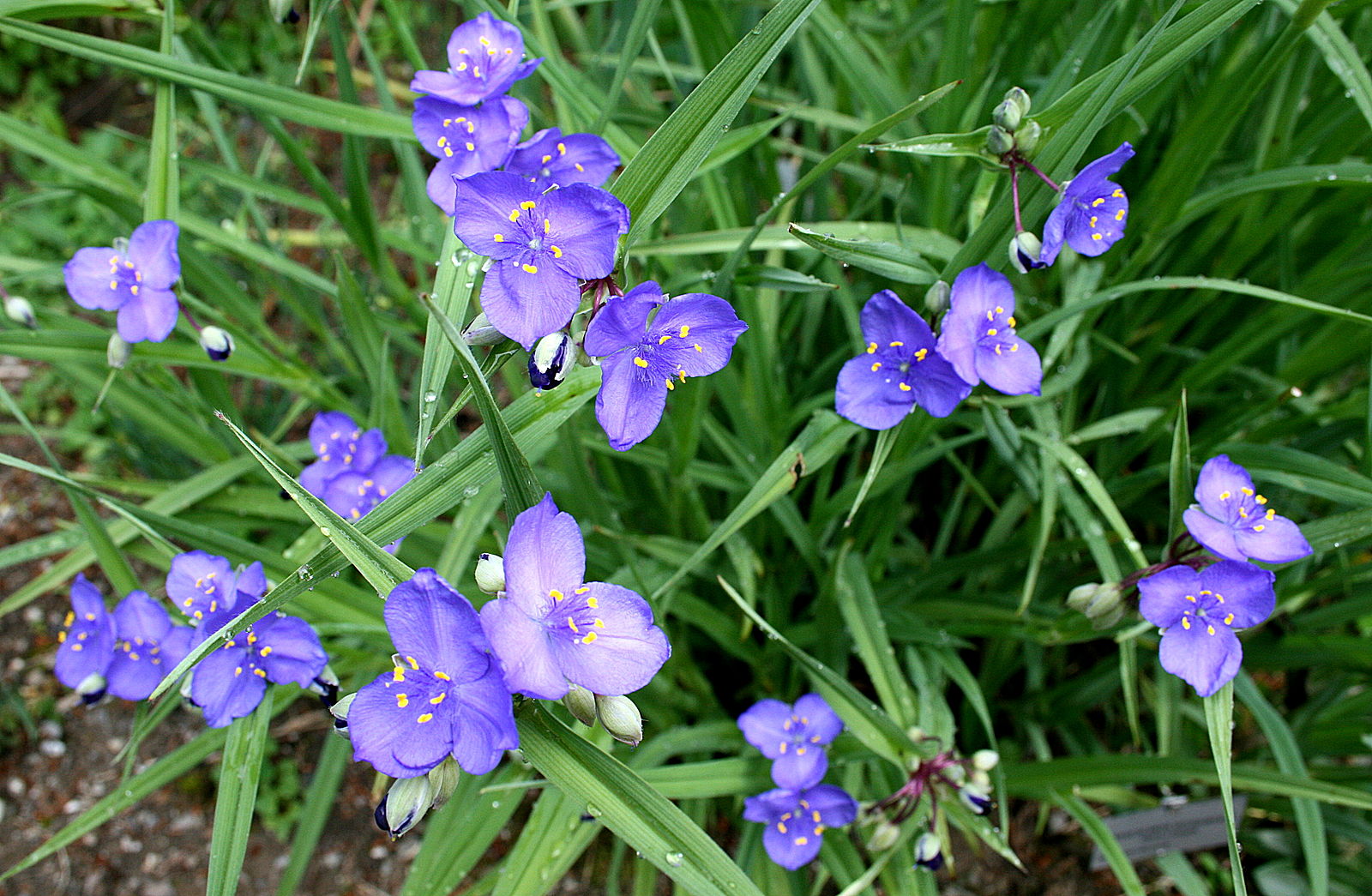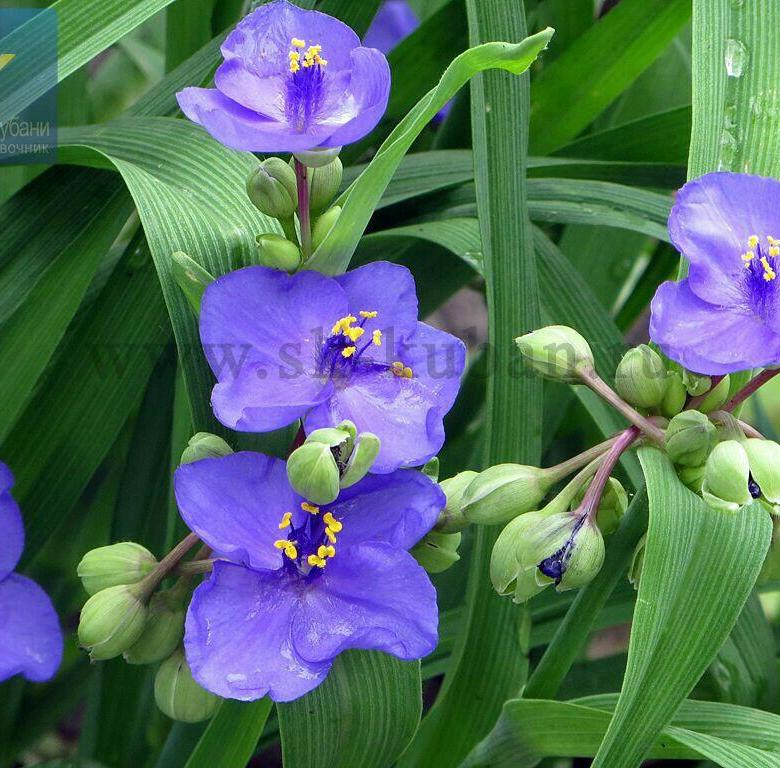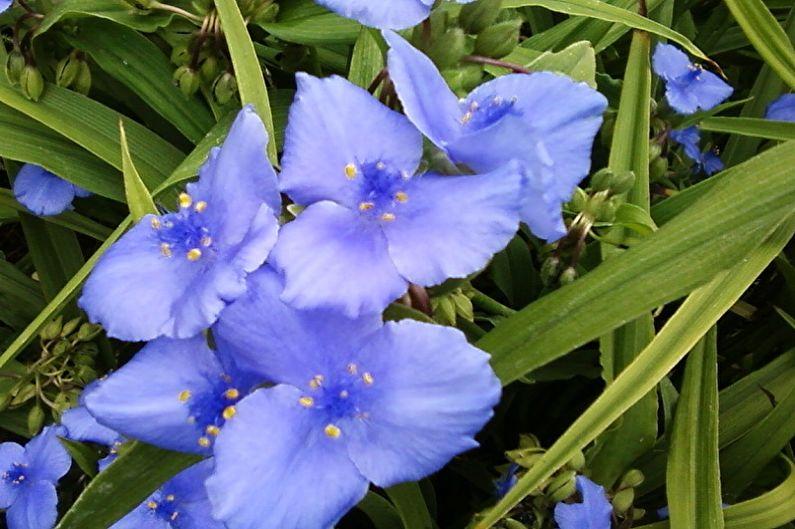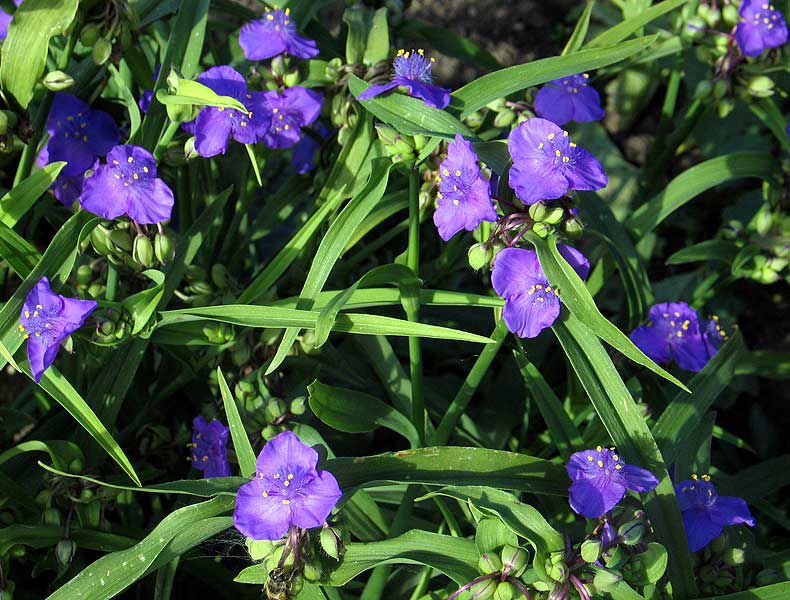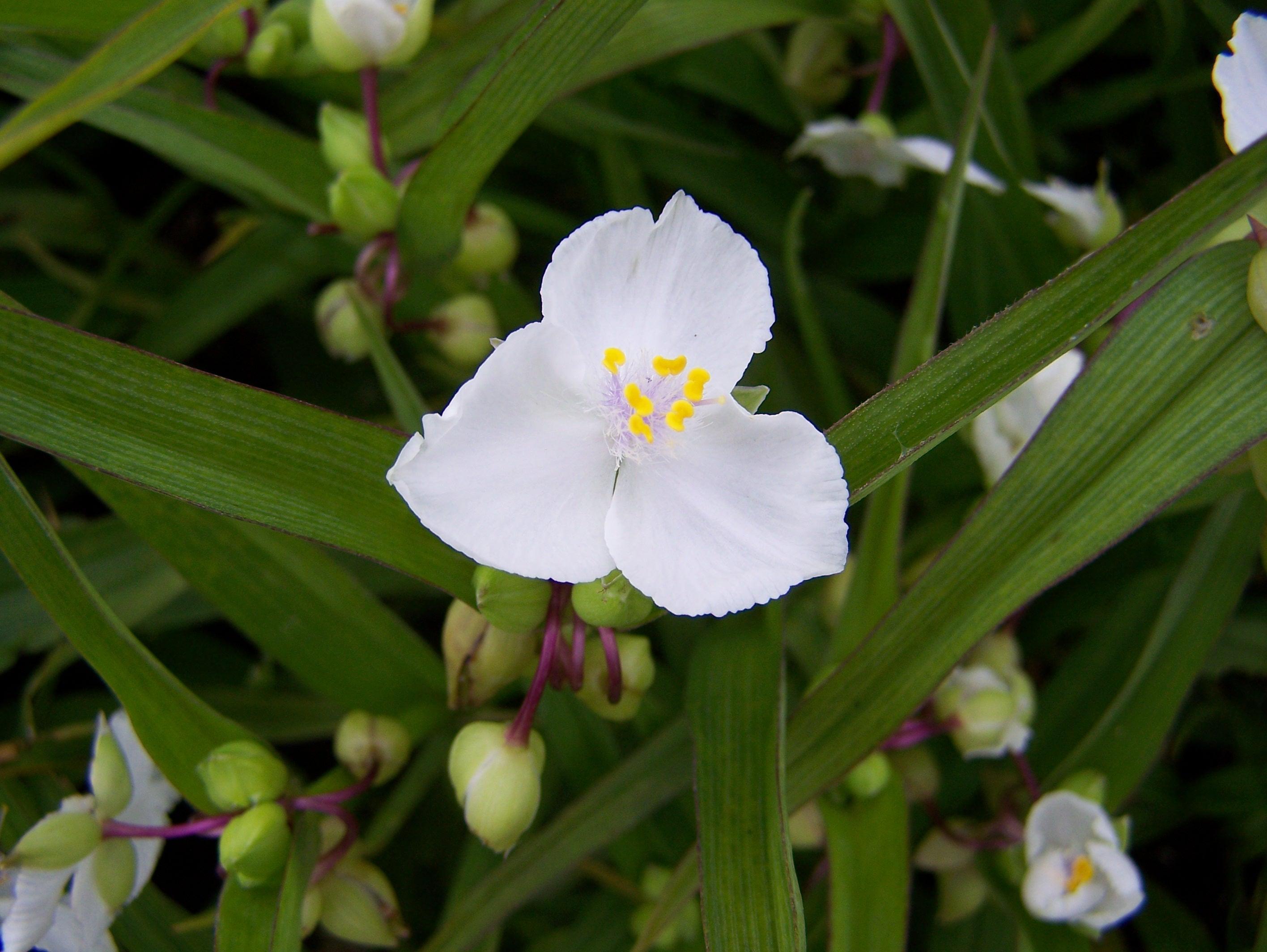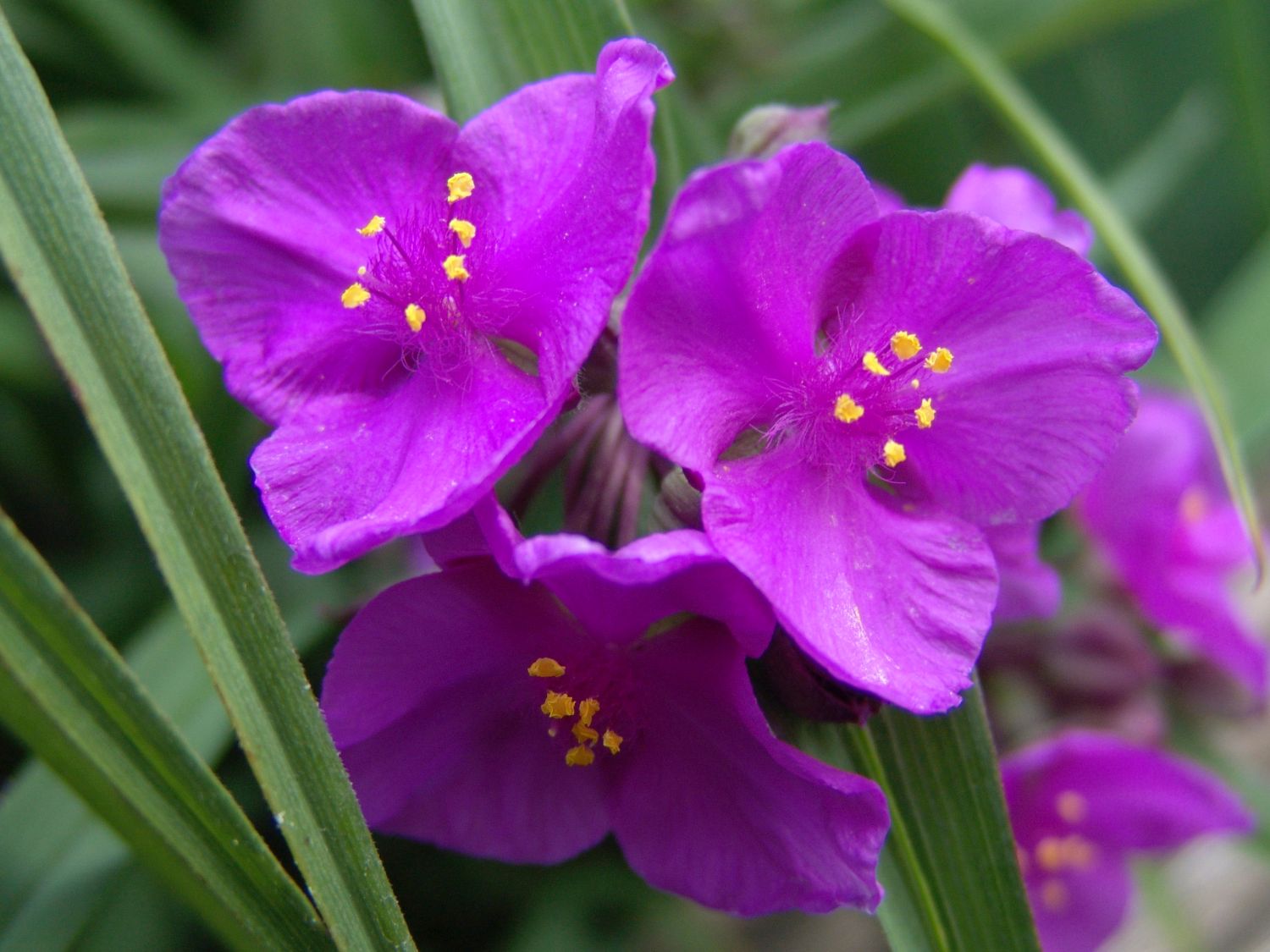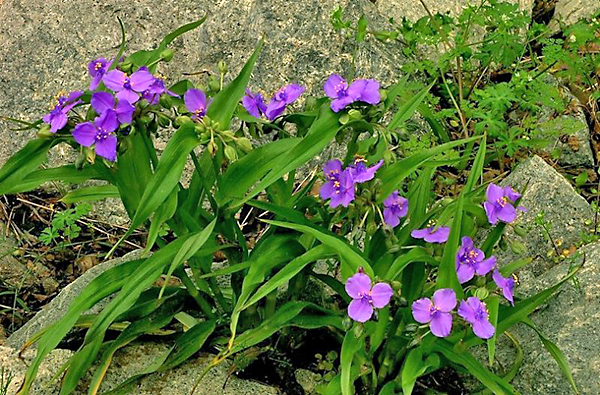White-flowered Tradescantia (Tradescantia albiflora)
In some types of Tradescantia, you can find not one, but several synonymous names. White-flowered tradescantia is no exception, which growers also know as tricolor tradescantia. In fact, the last name does not belong to the entire species, but only to the only variety in which pink stains and strokes are clearly visible on the striped, white-green foliage.
The plant from the South American tropics stands out for its smooth, pointed, cordate foliage, creeping knobby shoots and small white flowers that give the species its name.
In addition to the tricolor variety and plants with smoothly colored leaves, there are varieties such as Albo vittata white-flowered tradescantia, in which the leaves are decorated with many green and white stripes.
Planting and caring for Tradescantia
The place for growing Tradescantia must be selected very carefully: it should be either sunny or semi-shaded (it is better to give preference to a site with a lot of shade or near a pond). The soil for planting is extremely moist, nutritious (sandstone is best).
In order for the plant to grow strong and healthy, it is enough to follow the simple rules for the care of Tradescantia:
- Watering should be regular and generous, especially if the plant is in direct sunlight, as lack of moisture and excessive heat can cause the plant to stop growing, stop flowering, or even die.
- Top dressing should not be frequent, but it is better that they are present. For the first time, it is advisable to apply mineral fertilizer at the moment the first strong shoots appear; in the second - at the moment of bud formation. This will be enough for the plant to fully develop and delight you with luxurious and long flowering. If the plant was planted in a nutrient soil containing a large amount of clay, there will be no need for feeding in the next couple of years.
- Pests do not like Tradescantia, and diseases are not at all scary to it, therefore, no additional measures to protect the young plant at the time of planting are necessary.
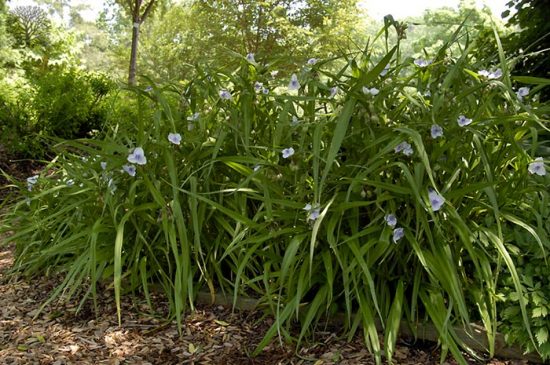 Tradescantia needs shelter for the winter
Tradescantia needs shelter for the winter
- Wintering is an important stage in plant care. Despite its unpretentiousness and resistance to the effects of cold, Tradescantia needs shelter during the cold season. So, before the onset of the first frost, it is better to cover the plant with fallen leaves - this will help protect it from freezing.
- Tying is required only in cases where the flowering is too thick and lush and simply bends the plant to the ground. You can avoid such a nuisance by tying the bush to a wooden support.
Advice. After the end of the flowering period of the plant, it is advisable to remove the peduncles from it, since otherwise seedlings may fall out of them into the soil, which will eventually germinate in the soil and will certainly spoil the appearance of the bush, since they will chaotically thicken it.
Reproduction and planting of perennial street tradescantia
Tradescantia lends itself well to reproduction. You can grow a flower using cuttings, dividing the bush and seeds.
Cuttings
Breeding cuttings should be cooked in the spring or summer so that they have time to adapt and get stronger before the winter frosts. The flower is propagated step by step:
- cuttings are cut from the tops of the stems, each specimen should have several internodes;
- the lower leaves are removed;
- planting material is placed for several days in a container with water or wet sandy soil;
- rooted cuttings are planted in a container for growing or in a shaded area;
- it is better to prepare the soil for young flowers in advance by mixing leafy and soddy soil with a small amount of sand.

The cuttings are watered regularly, but in moderation. The comfortable temperature for young sprouts is 22-24˚С.
By dividing the bush
Most often, it is the method of dividing the bush that is used for reproduction. To carry out this manipulation, you should remove the root part from the soil and divide it into several parts. You can not completely dig out the rhizome from the ground, but simply separate several roots with a shovel.
The separated parts are planted in a prepared place. Delenki are distinguished by their ability to easily and painlessly settle down on a new site. A flower grown in this way will delight with flowering already in the year of planting.
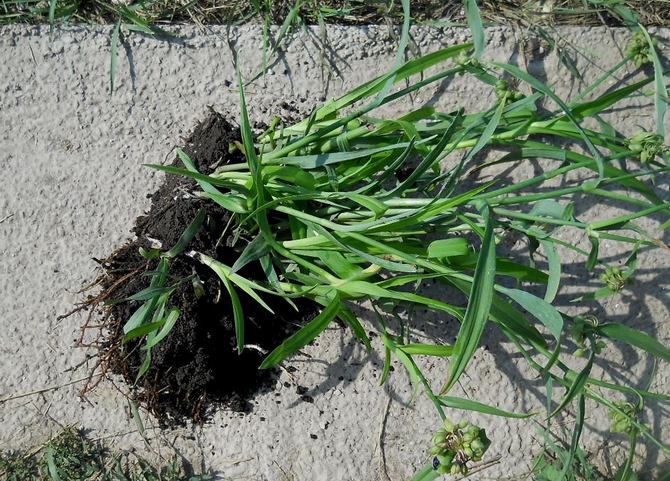
For the mother plant, such manipulations will only benefit - it will rejuvenate and develop more actively.
Seeds
During seed propagation, plants do not retain varietal characteristics. This method is used in breeding work when they want to develop a new variety. At home, you can also grow flowers from seeds. The landing procedure is carried out as follows:
- seeds are sown in winter, so that sprouts will dive with the arrival of spring;
- the soil in the container should be light. The bottom of the container must be filled with a drainage layer;
- seeds are planted down to 2 cm;
- the container is covered with a film to create greenhouse conditions;
- the planted seeds are transferred to a room with a temperature of about 24 ° C;
- it is better not to water the seedlings, but to regularly spray it with a spray bottle with warm water.
After the appearance of 2-3 full-fledged leaves, you can transplant the shoots into open soil. A seed-grown plant blooms after three years.
Planting procedure
The flower is planted with seeds, rooted cuttings or cuttings. Planting should be carried out in early spring, and when multiplying by dividing the root - in the fall. Before the procedure, you need to prepare the soil: remove weeds, dig up and feed with organic fertilizers, you can use humus, peat or vermicompost.
Landing is carried out as follows:
make small pits;
place a plant in them, holding it in an upright position;
at the bottom of the hole, carefully straighten the roots;
gradually fill the hole with soil, followed by compaction;
the flower should be in the ground up to the root collar, so that it deepens by 2-3 cm;
after planting, water the Tradescantia, and mulch the soil around the roots with humus.
The planted culture is covered for several days with a special material that will help protect against wind, night coolness or scorching rays. After 2-3 days, the flower adapts to the environment, and it will be possible to remove the shelter.
Use in landscape design
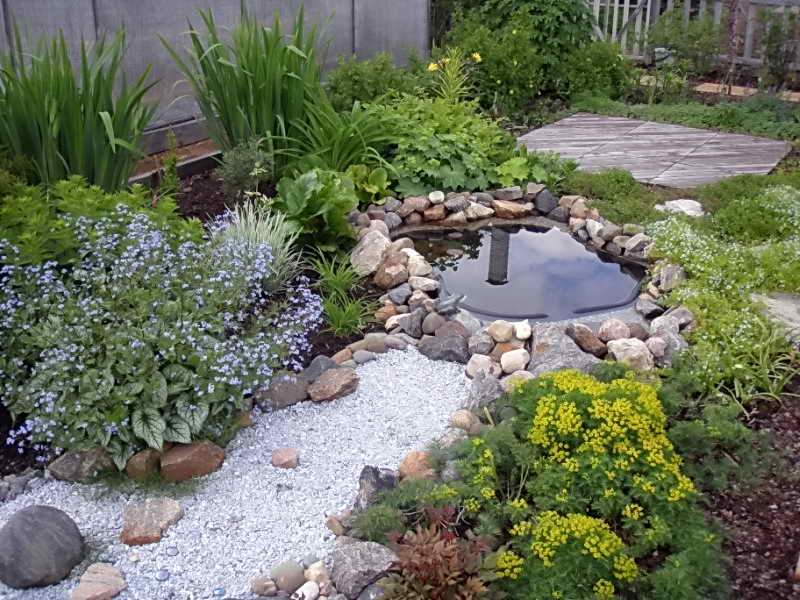
It goes well with daylilies, ferns, hosts, heucheras.
When planting a flower, it is important to take into account its features. Place the culture in slightly shaded mixborders, at the bottom of an alpine slide, near fences or in the shade of a house
You need to choose a place very carefully, because the color of the foliage and the duration of flowering depend on it. When planting tall varieties on the site, you should remember about the garter. You can pick up strong "neighbors", because well-chosen plants will be an excellent support and will look great on a flower bed.
It will also be interesting: Chrysanthemum multiflora (spherical) - planting and care, wintering in the open field?
Tradescantia: reproduction
The plant propagates very well by cuttings. All methods give almost 100% survival rate. For horticultural crops, the best time to breed is spring. Indoor flowers are recommended to be propagated in spring, summer and early autumn. It is better not to touch them in winter.
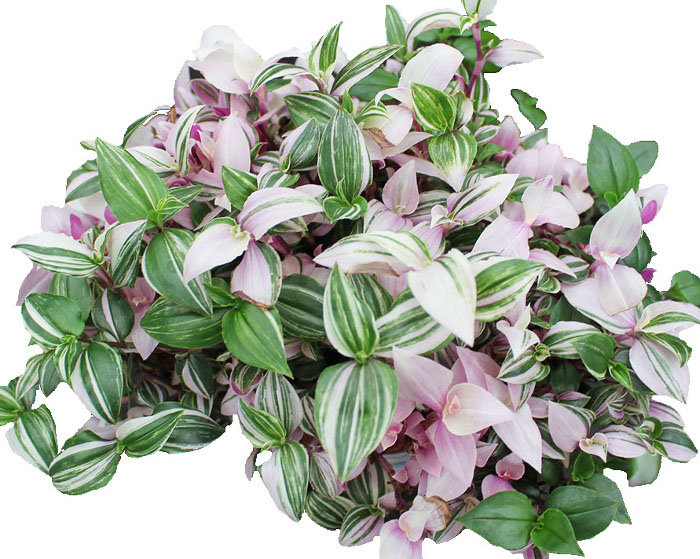
Tropical evergreen
Important! The stems of the plant are very fragile
Care must be taken when landing
How does it multiply
Plant propagation is possible in four ways. It:
- growing tradescantia from cuttings is asexual type of reproduction. With this method, the cuttings are rooted in water, then transplanted into the ground;
- rooting of layers. In the internodes of the lashes there are rudiments of roots. When in contact with the ground, they germinate quickly. They can be cut from the mother bush and planted;
- division of the bush. It is carried out with a spring transplant. The root is divided into parts and seated in separate containers;
- sowing seeds. The bush reproduces by seeds for a long time (2-3 years).
Growing from cuttings
The easiest way to get a new plant is by cuttings. Growing tradescantia from cuttings consists in cutting 12-15 cm pieces of a healthy shoot and rooting.
Important! Slices should be done under the nodes. Next, the planting material is placed in a container with water.
It is recommended to disinfect water with an activated carbon tablet
Next, the planting material is placed in a container with water. It is recommended to disinfect the water with an activated carbon tablet.
After 1.5-2 weeks, roots appear. The seedlings are ready to be transplanted into individual pots. For a larger bush for one pot, you can select several seedlings, since it is not enough to propagate Tradescantia, you need to decorate the bush beautifully.
An important condition for the successful development of an indoor flower is soil fertility.
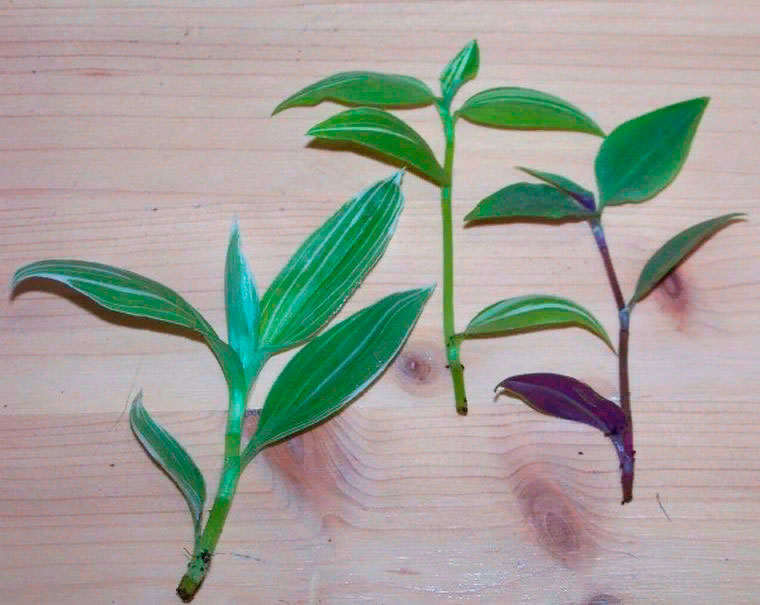
Cuttings must be done carefully.
Often, flower growers bypass the stage of water rooting and plant fresh cuttings immediately in containers with soil. Subject to the temperature and humidity conditions, this method is quite justified.
In both cases, after 1.5-2.5 months, it is realistic to get a mature bush.
Garden tradescantia in landscape design
The decorative long-blooming perennial has long been used by landscape designers to decorate flower beds, create flower arrangements, decorate the coastal zone of a reservoir, etc.
Garden Tradescantia looks great with other flowers, shrubs and herbaceous plants
When drawing up decorative compositions, it is important to take into account the height of the plants so that they do not cover, but complement each other. The most successful are the combinations of aesthetic Tradescantia with ferns, heucheras, daylilies, hosts and astilbe.
- Taking into account the preferences of perennial culture, it is planted in shaded mixborders, in the lowlands of alpine hills, near fences or in the shade of any buildings. A well-chosen place will provide the owners of the garden beauty with bright greenery and an abundance of delicate flowers throughout the warm season.
- When choosing a variety of tradescantia, one should remember about the possible lodging of tall tradescantia (especially in open and unprotected areas), which will significantly worsen the decorative attractiveness of the flower garden. In this case, well-chosen "neighbors - plants" can become a real natural support for the spreading bushes of Tradescantia.
Summing up, we note that the garden tradescantia is a hardy and unpretentious plant grown in the open field. Among the main requirements for the successful cultivation of a perennial and long-blooming beauty are constantly moistened soil and diffused lighting. Separation and replanting (every 5 years) of an overgrown Tradescantia shrub ensures the rejuvenation of the plant, significantly increasing the intensity of flowering. A vibrant and decorative culture is indispensable in the design of many landscape designs, in particular when drawing up a variety of flower arrangements.
2 Growing tips from experienced gardeners
Tradescantia can grow in one place for several years. Landing is carried out in prepared soil in a well-lit place. Preference is given to soft sandy, well-drained soils. There should be no drafts or strong winds in the selected area. It is necessary to abandon planting a plant in a place where moisture is poorly retained.In such a soil, you can add moisture-retaining material, for example, clay, compost, rotted sawdust. Slight shading by trees or buildings is allowed. If you plant Tradescantia in a completely darkened place, then flowering will not come.
The soil needs to be moistened periodically. In too dry areas, regular artificial watering is organized. When cold weather sets in, the amount of moisture is reduced. Properly performed care will allow you to get bushes with abundant flowering
It is important not only to water the soil, but also to spray the leaves periodically. You need to do this in the evening.
Before planting, the soil is well fertilized using organic matter. Suitable humus, compost, peat or vermicompost, which are poured directly into the planting pit. The amount of fertilizer is selected so that it is enough for the entire root system. The pit must be watered. If the tradescantia bush has developed shoots, then the root collar after planting is 2 cm lower from the ground level. In the case when the bushes are partially cut off, the growth point must be deepened already up to 5 cm. After planting, it is necessary to water the plant again. Mulching with peat or humus is recommended.
Caring for Tradescantia includes fertilization. The first top dressing will be applied in the spring when all weeds have been removed. For this, mineral fertilizer is used. It is applied to a depth of 8 cm. The second top dressing is performed in May using liquid nitrogen fertilizer. Once every 20 days, you need to loosen the soil around the plant and apply complex fertilizers. When buds appear, potash and phosphate fertilizers will need to be applied.
At the beginning of October, the plant is being prepared for wintering. Cropping of the ground part of flowers is necessary. The plot is mulched with humus or peat. Such activities will help protect the plant from freezing in cold weather.
It is important to cover newly planted plants for the winter. They can be covered with leaves or peat.
After winter, Tradescantia "wakes up" at different times. It all depends on the age of the bush.
Perennial Tradescantia, planted in open ground, is resistant to pests and various diseases. Slugs, nematodes harm the plant the most. In too dry weather, bronze beetles eat stamens. If the site is infested with nematodes, the above-ground part of the plant will have to be removed. These residues are burned to prevent the spread of pests.
Pests
Tradescantia is affected by pests such as aphids, scale insects, thrips and spider mites. They usually appear in too hot, dry or stuffy, rarely ventilated rooms on the underside of the leaves. If you do not take urgent measures, the parasites will spread throughout the bush and in a short time spoil not only its decorative appearance - the plant may die. At the first sign of pests, take Tradescantia to the bathroom and wash off the insects with warm water and a solution of laundry soap (watering can or sprayer). Then, the dried plant should be treated with a suitable insecticide. If you are in doubt about the name of your sucking parasite, take a picture of it with your phone. Contact any flower shop, where the seller, using your photo, will select the desired drug and give instructions for its use.
Popular types
There are dozens of varieties of this plant in nature, but only a few representatives of the genus are most in demand on the territory of Russia.
- Anderson. Dense bushes of this selection variety can reach a height of 80-100 cm. The branches are characterized by increased fragility. Leaves up to 20 cm long are located on them. They are painted in a rich green color, and the flowers can be blue, white, pink or purple.
- Virginskaya. This variety has a more modest size: the average height of the bush reaches 30-40 cm.On erect, strong stems, arrow-shaped leaves of bright green or dark color are attached. It blooms in pink, bright red or light blue flowers. Virginia Tradescantia in planting and care is undemanding, which means it is suitable for most regions of the country.
- Long-rhizome. A miniature representative of the genus, which rarely exceeds 10 cm in height. On the juicy fragile shoots are light green leaves and flowers of delicate blue and pink color. This species is characterized by increased resistance to drought.

Giant. Such a Tradescantia is a perennial garden flower that, despite its name, grows no higher than 40 cm. You can recognize this variety by its wider leaves and fluffy sepals.
Ohio. This is one of the largest species, its bushes in natural conditions often reach 1-1.2 m. The leaves of the plant are large, wide, covered with a light whitish bloom. There are villi on the sepals. The buds are often pink or blue, but there are also white buds.
Subaspera
Such tradescantia on the street will surely attract attention. Its zigzag stems can reach a height of 1 m
The leaves of this plant are wide, bright green, often bare, but may have villi. The flower petals are light blue in color.
When garden tradescantia blooms
With good care, the plant begins to bloom in the spring with the onset of warm weather. The flowering period ends in late autumn. Thanks to this feature, the perennial is widely in demand among flower growers and landscape designers.
Types of tradescantia photos and names
White-flowered Tradescantia - the shoots of this species are creeping, and the leaves are oval elongated, green in color, but there is also a variegated variety. Inflorescences are small in size, white in color. Different varieties of this species have different interesting variegated colors.

Tradescantia Blossfeld - The creeping stems of this species are reddish in color. The lower side of the leaf is purple. Inflorescences are pink-white, sepals are purple. There is also a variegated variety in which the leaves are decorated with yellow lines.

Anderson's Tradescantia is a common name for hybrid varieties derived from the Virginian species. Lanceolate leaves with a purple tint, flowers of different colors form umbrella inflorescences.
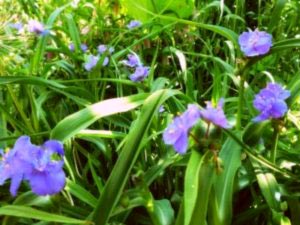
Virginia Tradescantia - has straight, branched shoots that grow above 50 cm. The leaves are long, lanceolate. The flowers are purple with a pink tint. There are varieties with a different color of inflorescences.
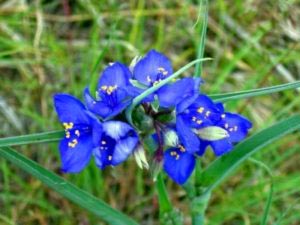
Tradescantia is zebra-like or hanging - has red stems, leaves about ten centimeters long, oval in shape. The leaf is decorated with a pair of silvery lines. Inflorescences are purple in color.

Riverside Tradescantia, also called myrtle-leaved - creeping scarlet-purple stems with a green tint. The leaves are round, small. There are variegated striped varieties.
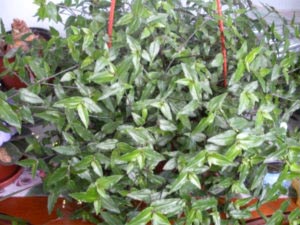
Sillamontana Tradescantia is densely covered with white fluff, which serves to protect from the bright sun, so this species must be placed in brightly lit places, otherwise the fluff will disappear.

Small-leaved Tradescantia is one of the smallest species. The leaves are small, green in color, covered with small dark spots.
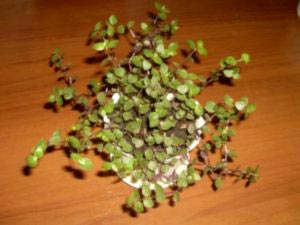
Tradescantia rheo or vellate - wears xiphoid olive-colored leaves. Forms a not very large bush. It is mainly distributed as an indoor flower. You can find detailed information on growing and caring for a rheo flower at home here.

Tradescantia is pale or purple, in fact, it is a plant of a different species. This is purpurea reticulum, which is confused with tradescantia. This plant has very long shoots that grow up to a meter. Leaves with a purple tint, slightly covered with fluff below, purple. It has small pink flowers.
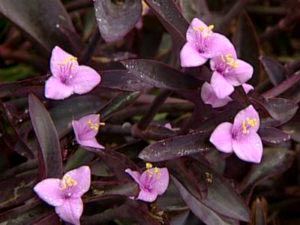
3 Tradescantia in landscape design
From the wide variety of plants on the site, white or purple Tradescantia always stands out effectively. They have many flowers on the bushes, which can form colorful clusters. They have no smell, so the plant does not attract bees, bumblebees. It is better to remove faded flowers. New buds will appear in their place. This will allow the bush to bloom for a long time.
It has long been believed that this plant protects against ill-wishers and envious people. The flower purifies the air, neutralizes electromagnetic rays. This explains the popularity of Tradescantia. You need to enjoy the beauty of the bush that is on the site for 30 minutes a day. This will help relax your eyes, calm your nerves. Due to the wide variety of Tradescantia varieties, interesting combinations can be selected. To avoid tying the bushes, the bushes should be planted tightly to each other.
There are other landing options. For example, you can plant Tradescantia as a tapeworm somewhere in partial shade. For this, tall varieties are used. Over time, the bush will acquire a beautiful hemisphere shape. He will have cascading shoots that will decorate the flowers.
Vigorous bushes are sometimes problematic. This is due to the fact that they do not hold their shape well. After abundant watering, the plant lodges. It is better to tie up such bushes. In a dark place, Tradescantia also loses its stability and begins to stretch. Bushes do not lose their compactness in a small shade or in the sun. To avoid tying tall bushes, experienced gardeners use the following "neighbors": hosts, brunners, bathing suits, astilbe, anemones. It is good to plant cuffs, lungwort, geraniums, gravilates near a low-growing Tradescantia. They not only support the bush, but also help create spectacular compositions on the site.
Purchase and adaptation period
When buying Tradescantia, pay attention to its appearance. In a healthy plant:
- rich foliage color;
- there are no spots on the vegetative mass;
- the roots are intact, without signs of rot.
After purchase, the flower is not transplanted and no fertilizing is applied for 2 weeks - this is necessary to adapt to new conditions.
Boarding and transfer rules
For a horticultural culture, a permanent place of growth is chosen, because it grows without transplanting for up to 10 years.
Technology:
- fertile soil is prepared for planting, enriching it in advance with organic matter - manure, humus or compost;
- the beds are cleared of weeds and form shallow trenches with a depth depending on the species planted;
- seedlings are placed strictly vertically, straightening the roots, covered with soil mixture, leaving the root collar 2-3 cm above the soil surface;
- after planting, the plants are watered, the ground is mulched with peat or dried grass.
For rooting of indoor seedlings, they are covered with covering material. After adaptation, the shelter is removed.
For tall varieties, supports are installed.
Only the overgrown Tradescantia is transplanted. It is advised to carry out the procedure every 5 years, combining transplantation with reproduction by dividing the parent plant.
Rules for growing tradescantia
The presence of flowering. Do not expect lush flowering from the Tradescantia plant, it belongs to the representatives of decorative deciduous.

Photophilousness. The flowerpot is unpretentious to light. It can grow in both dark and well-lit places. However, direct sunlight is harmful. The best conditions are diffused light.
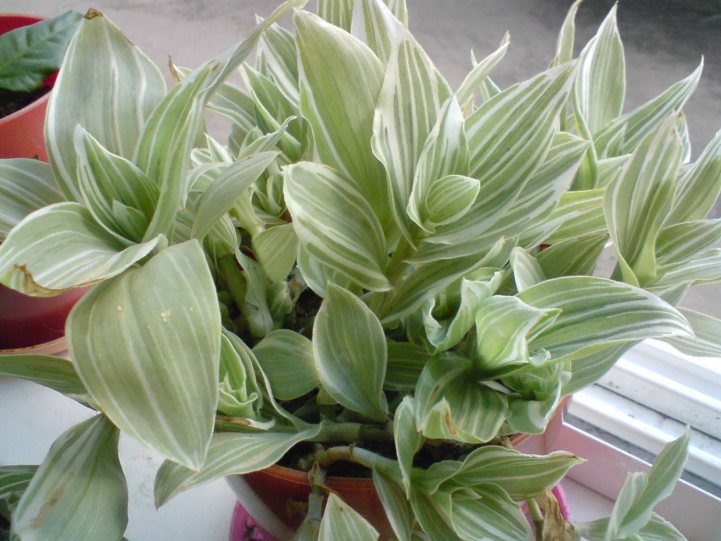
Temperature. Comfortable air temperature in the warm season is up to 25 degrees, in the cold - no higher than 12.
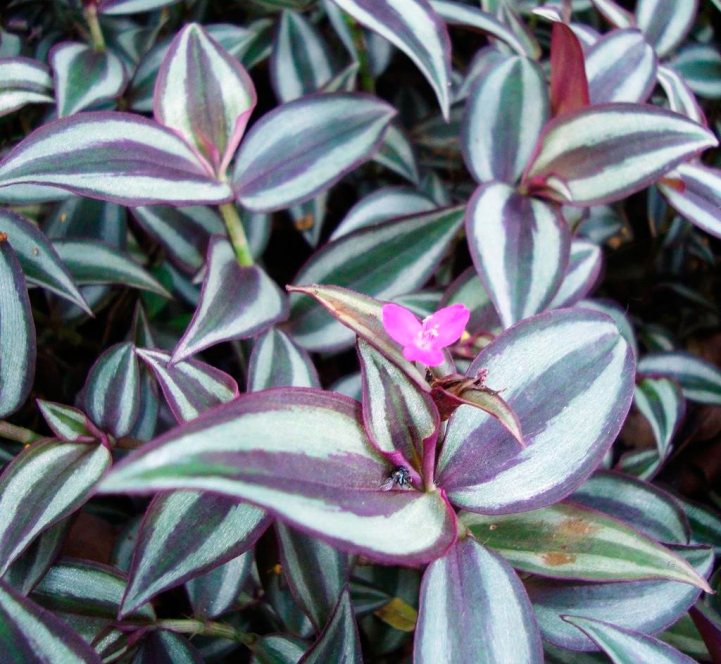
Watering. More moisture is required in summer, in winter watering is necessary when the soil in the flower pot is completely dry.

Moisture content. Good growth is achieved in normal humidity conditions.
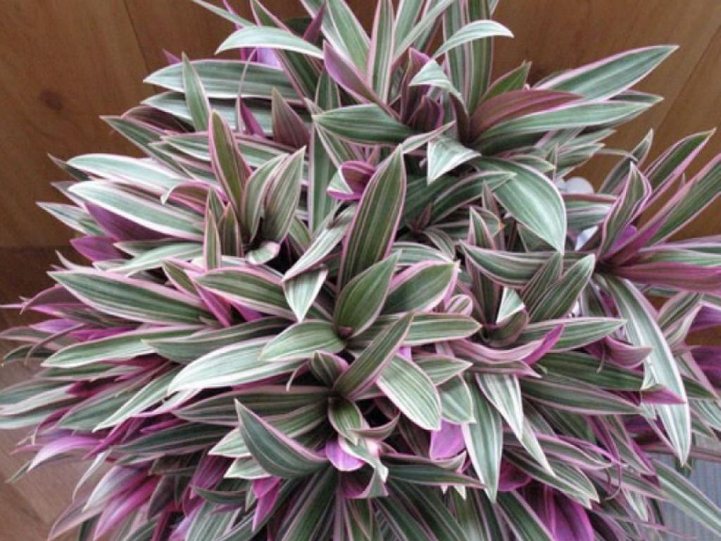
Top dressing.You need to fertilize the flower in spring and summer after fifteen days, alternately using organic and mineral fertilizers.
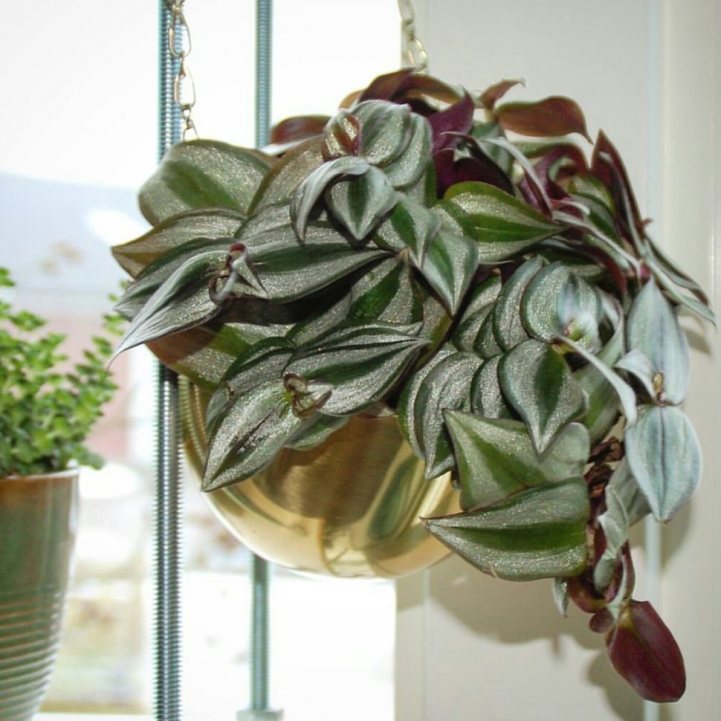
Time for a sanitary haircut. In the spring.

Transfer. The plant is transplanted in the spring. Young bushes are transplanted annually, matured - once every 2-3 years.

The soil. Ready-made mixtures for indoor plants, special soils for tradescantia, self-prepared substrates (for four volumes of deciduous soil, two volumes of turf and humus and one volume of sand).
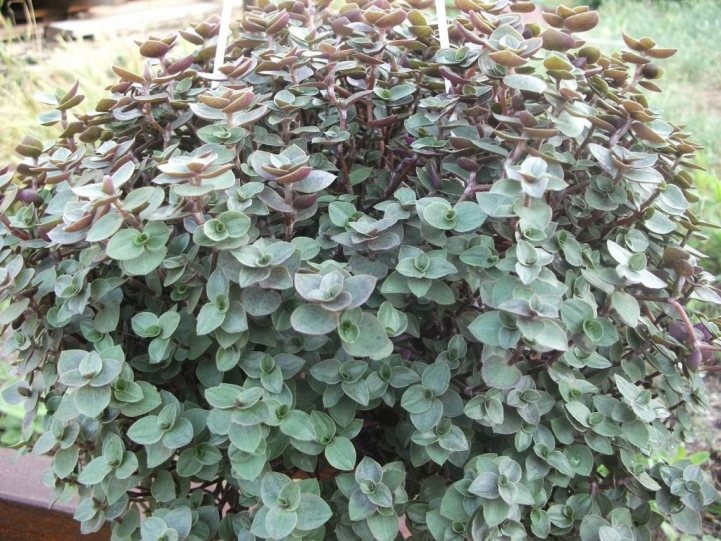
Pests. Thrips, scale insects and spider mites.

Diseases. Most often appear in connection with improper care. They appear as bare shoots, rot, fading and spotting of leaf plates.
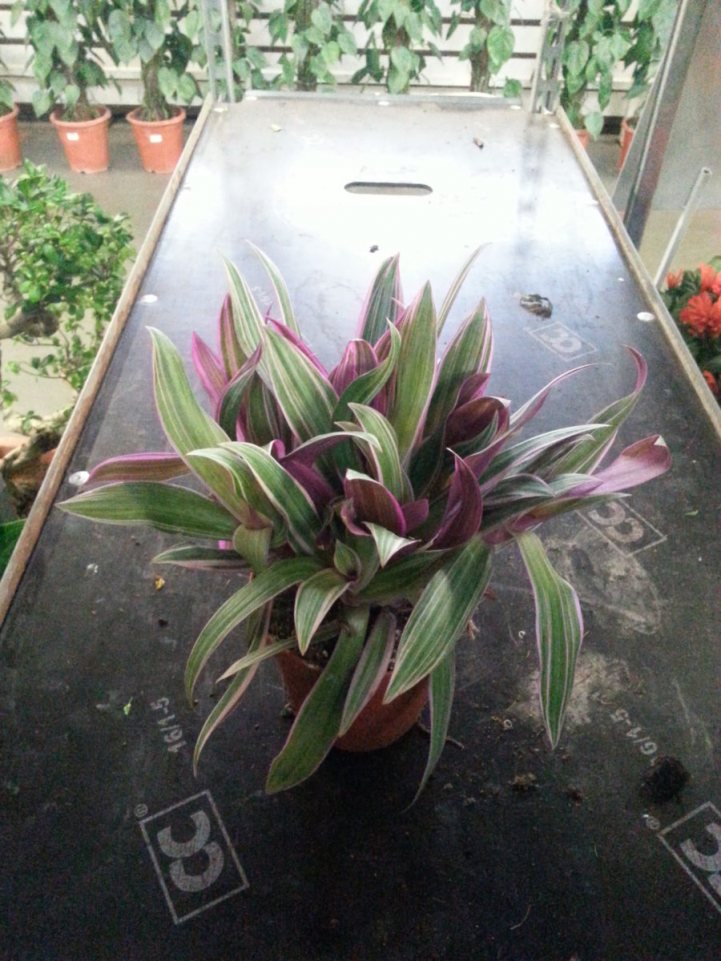
Poisonous properties. Sometimes, when working with a plant, skin dermatitis appears on the hands. In order to avoid this, it is necessary to wash your hands well after contact.

Garden Tradescantia, planting agricultural technology
Growing tradescantia garden does not require special knowledge or skills. The flower is relatively unpretentious to growing conditions, easily takes root in a new place and requires a minimum of attention.
Considering that a perennial plant can grow in one place (without transplanting) for more than ten years, special attention should be paid to the correct choice of a place for planting.
Place for planting irdescantia sadovaya
- Moisture-loving Tradescantia prefers sheltered, moderately lit, plots of land.
- An ideal place for planting Tradescantia garden would be a not very open site located in partial shade and near a reservoir. Too sunny terrain will have a detrimental effect on the development of a moisture-loving culture: the plant will first stop blooming, and then completely die. Excessive shade is also not desirable, since under such conditions, flowering may not occur at all. In addition, Tradescantia does not tolerate drafts and gusty winds.
- The most advantageous place for the growth of flower culture and the guarantee of long-term abundant flowering will be a site illuminated by the sun in the morning and evening, but shaded (by other plants or buildings) on a sultry afternoon. An alternative can also be an area with diffused lighting throughout the day.
- Planted in a sunny, dry area, Tradescantia needs regular and abundant watering. Otherwise, the development of the plant slows down significantly or stops completely.
- Too close water is also not desirable. So, when planting Tradescantia near the coastal zone of reservoirs, you should step back from the water's edge and plant it a little further.
- The soil should be light, nutritious, loose, with a slightly acidic reaction of the medium. The best option is moist, fertile soil with a high organic content. Air-permeable soil mixture should include sod and leafy soil, sand and humus.
Planting Tradescantia Sadovaya
- You can plant a perennial with seeds, cuttings or rooted cuttings. It is better to do this in early spring or, in the case of divisions, in autumn. A plant planted with seeds will bloom only in the 3rd year of life.
- Before planting, the site should be prepared: cleaned of weeds, loosen, add organic matter. In the case of poor, dense and humus-depleted soils, complete removal of the top layer of the earth is practiced, followed by the laying of a high-quality structural soil mixture.
- Vermicompost (biohumus), peat, humus are used as organic fertilizers. Planting soil mixed with organic matter is ready for use and planting.
- When planting tradescantia, small pits or grooves are prepared. A plant is planted in the holes with fertile soil, holding the bush vertically. At the same time, at the bottom of the hole, you need to carefully spread the roots and gradually, pouring in and compacting the soil, fill in the roots to the level of the root collar.
- When properly planted, the root collar should be 2-3 cm below ground level.
- After planting a garden tradescantia, the plant is watered, and the trunk circle is mulched with peat or humus.
- If, prior to planting Tradescantia in open ground, the plant was in other conditions (in a greenhouse, on a windowsill), you should help it adapt to new conditions and reduce the stressful impact of the environment. For this, the seedling is covered for several days with a special non-woven covering material that prevents the penetration of direct sunlight. After 2-3 days, when the plant is completely rooted, the shelter is removed.
Diseases and pests
Diseases occur most often due to improper care of Tradescantia. For example, with a lack of light, the stems will begin to stretch, and the foliage will thin out. With a lack of moisture or too direct sunlight, the leaves turn brown. Normal conditions should be created to correct problems.
As the crop ages, the stems are exposed at the base, and the only recourse is to use the tops of the shoots as cuttings. The rest of the plant is discarded.
Another ailment that a culture can comprehend is a sooty fungus that settles on leaves in those places where traces of scale insects or aphids are left. It provokes a violation of respiration and photosynthesis, which leads to the weakening of the plant.
Like all decorative flowering crops, Tradescantia is not ignored by various pests, for which it becomes a real delicacy. The following representatives are especially dangerous:
Aphids are a sedentary insect that feeds on cell sap, as a result of which the foliage shrivels and the buds fall off. It is necessary to wash the plant with soapy water and treat it with Aktellik.
The spider mite is so small that it can be seen only in group colonies that look like pollen on the leaves. Signs of damage are determined by leaf fall and the presence of a thin web. Tradescantia must be thoroughly bathed and more humid.
Scale - settle on the underside of the leaf and feed on its juice, leaving a sticky discharge. Careful pest removal and insecticide treatment will be required.
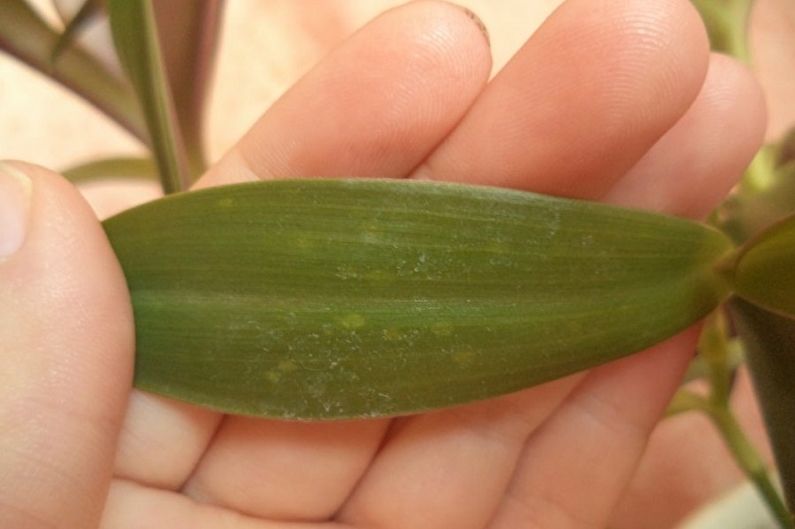

Reproduction methods
Tradescantia reproduces easily by any means. Recall that hybrid crops are not bred with seeds, since their own sowing material is defective, the properties of the mother plant are not transferred.
Seeds
Planting by seeds is practiced by breeders, since the plant blooms only in the third year. Vegetative methods are faster and retain varietal properties.
The seeds are planted in containers with a laid drainage layer and light nutritious soil. Deepening - 2 centimeters. The containers are covered with foil or glass, placed in a warm place (22-24 °). Watering is carried out from a spray bottle.
When 2-3 leaves appear, Tradescantia is dived into individual pots or immediately transplanted into the ground.

Cuttings
The easiest way to get an exact copy of varietal Tradescantia is by planting cuttings. It is carried out in late spring or the first half of summer, so that the seedlings are strengthened and overwintered without problems.
Choose strong healthy shoots, cut off the upper part with 3-4 nodes, remove the lower leaves. You can germinate cuttings:
- on a shaded area of open ground, if it is possible to water regularly;
- in water;
- in a container with sand and peat.
The roots appear quickly (1-2 weeks), the tradescantia is transplanted from a container or water to a permanent place. After 1.5-2 months, the plant takes root on the site and takes on a completely decorative look.
Dividing the bush
Usually, by 4-5 years of age, the Tradescantia bush becomes too large, thickened, and it can be rejuvenated, and the plant can be propagated. In the spring, Tradescantia is dug up or simply separated in the soil with a shovel of a part of the bush and transferring the cuttings with roots and earth to a new place.This method gives a quick result - both parts bloom in the current year, the cuttings take root without problems.

